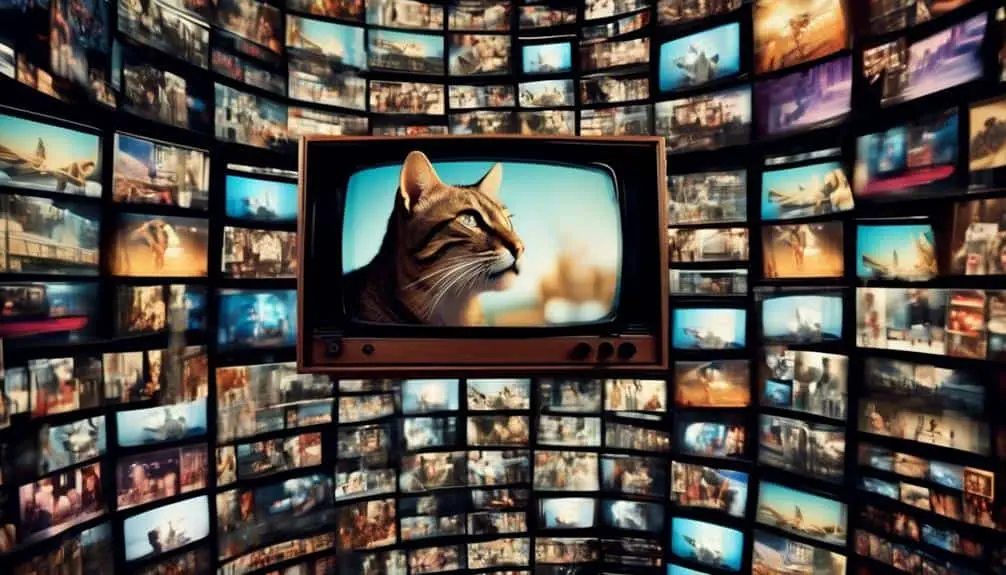The Best Fluffy Pancakes recipe you will fall in love with. Full of tips and tricks to help you make the best pancakes.

Television shows have long been a source of entertainment for humans, captivating audiences with their moving images and compelling narratives. But have you ever stopped to consider how our feline friends perceive these flickering screens?
While we may be engrossed in the drama unfolding before us, cats experience TV shows in a different way. Their unique sensory perception and visual capabilities shape their viewing experience, leading us to question whether television is truly a form of feline entertainment or merely a series of flickering stills in their eyes.
As we delve into the fascinating world of how cats process TV shows, we will uncover the secrets behind their visual perception, color palette, low-light vision, and sensitivity to sound. Prepare to be intrigued, for what we uncover may forever change the way you view television with your feline companion.
Key Takeaways
- Cats perceive TV shows as flickering still images due to their rapid frame rate and limited visual processing capabilities.
- Cats do not see in technicolor and have a muted color palette, making naturalistic images more appealing to them.
- Cats have excellent low-light vision, allowing them to easily see the screen in dimly-lit rooms.
- Cats are extra sensitive to sound, and keeping the volume low is important to protect their ears and ensure their comfort while watching TV.
How Cats Process TV Shows
Cats process TV shows differently from humans, perceiving the flickering stills on the screen as a series of rapidly flashing images rather than a coherent moving video. This unique perception affects how cats perceive motion on TV and can have an impact on their behavior and emotions.
While humans process 30 to 60 frames per second, cats require at least 100 frames per second to perceive smooth motion. Cats may enjoy newer TVs with a high refresh rate, as it enhances the illusion of movement for them.
Additionally, cats' visual system is not as sensitive to color as humans, preferring naturalistic images with a limited color palette.
Understanding how cats perceive TV shows allows us to create a more enjoyable and engaging viewing experience for our feline friends.
TV Shows May Look Like Flickering Stills to Cats
Perceiving TV shows as a series of rapidly flashing images, rather than a coherent moving video, is a unique characteristic of how cats process visual stimuli. While humans process 30 to 60 frames per second, cats need at least 100 frames per second to perceive smooth motion on the screen. As a result, TV shows may appear as flickering stills to cats.
However, the impact of high refresh rates on cats' enjoyment of TV shows is not yet fully understood. It is possible that cats may find newer TVs with high refresh rates more engaging, as the illusion of movement is better.
Further research is needed to explore the visual perception differences between cats and humans while watching TV and to determine the optimal refresh rates for cats' enjoyment.
Cats Don't See in Technicolor
The visual perception of cats differs from that of humans when it comes to color vision. Cats and color perception are intrinsically linked, as cats don't see in technicolor like humans do. This has an impact on their TV experience, as the limited color palette affects how they perceive the content.
Here are some key points to consider:
- Cats have two cone photopigments, compared to humans' three, which allow the eyes to detect colors.
- Cats see in a muted color palette with fewer vibrant hues, so colorful shows may not be as appealing to them as they are to humans.
- Cats may prefer naturalistic images with a limited color palette, as it aligns more closely with their visual perception.
- The impact of the limited color palette on cats' TV experience means that they may not fully appreciate the vibrant colors and visual effects that humans enjoy.
Cats Have Excellent Low-Light Vision
The impact of cats' visual perception extends beyond their limited color palette; they also possess excellent low-light vision. Cats have the ability to detect light levels up to six times lower than humans, allowing them to easily see the screen in a dimly-lit room. This enhances their TV watching experience, as they can comfortably view the show even in low light conditions.
However, it is important to note that what may seem like a comfortable room with a faint glow to us may actually be too bright for cats. Different lighting conditions can significantly impact their perception of TV shows, so it is essential to create a suitable viewing environment for them.
Cats Are Extra Sensitive to Sound
Cats' heightened sensitivity to sound necessitates careful consideration when it comes to their TV watching experience. The impact of loud sound on cats' TV watching experience is significant, and it is crucial to understand their preferences for lower volume levels. Here are some key points to consider:
- Cats' sense of hearing is more sensitive than humans', so what may seem like normal volume to us can be deafening or uncomfortable for cats.
- Cats may prefer lower volume levels while watching TV to protect their sensitive ears.
- Keeping the volume low is important for cats' comfort and to avoid potential hearing damage.
- Adjusting the volume to a level that doesn't cause discomfort is essential when watching TV with cats.
Conclusion
In conclusion, understanding how cats perceive TV shows can help us create a safer and more enjoyable viewing experience for our feline friends. While cats may see TV shows as flickering stills and have a different color palette, their excellent low-light vision and sensitivity to sound make them unique viewers.
By taking precautions such as securing the TV and adjusting the volume, we can ensure that our cats have a stimulating and enriching entertainment experience.








